

Nedergaard Lab. Figure 1: Modules of the human head identified using AnNA. Neurobites: Detection of Threat and Safety - Integrated Listening. What is the process through which the nervous system evaluates risk outside of your conscious awareness?

A. Interoception b. Neuroception c. Sympathetic nervous system d. Parasympathetic nervous system If you chose Neuroception, you are correct! Your body has a system that is on the constant lookout for whether situations or people are safe, dangerous or life threatening. Further explanation: MIT discovers the location of memories: Individual neurons. Update 12/2/15: We’ve now followed up on this story: The more we learn about memory, the weirder it gets.
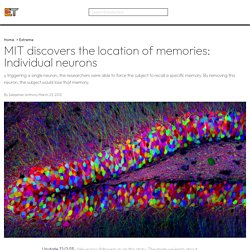
The original continues below. MIT researchers have shown, for the first time ever, that memories are stored in specific brain cells. By triggering a small cluster of neurons, the researchers were able to force the subject to recall a specific memory. By removing these neurons, the subject would lose that memory. As you can imagine, the trick here is activating individual neurons, which are incredibly small and not really the kind of thing you can attach electrodes to. Now, just to temper your excitement, we should note that MIT’s subjects in this case are mice — but it’s very, very likely that the human brain functions in the same way. In the experiment, MIT gave mice an electric shock to create a fear memory in the hippocampus region of the brain (pictured above) — and then later, using laser light, activated the neurons where the memory was stored.
Cognitive Atlas. Brain Structures and Their Functions. The nervous system is your body's decision and communication center.
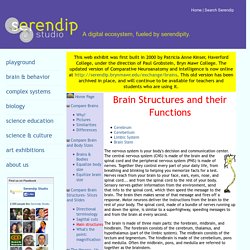
The central nervous system (CNS) is made of the brain and the spinal cord and the peripheral nervous system (PNS) is made of nerves. Together they control every part of your daily life, from breathing and blinking to helping you memorize facts for a test. Nerves reach from your brain to your face, ears, eyes, nose, and spinal cord... and from the spinal cord to the rest of your body. Sensory nerves gather information from the environment, send that info to the spinal cord, which then speed the message to the brain.
Nuerobiology. Researchers May Have Discovered The Consciousness On/Off Switch. Researchers from the George Washington University have managed to switch consciousness on and off in an epileptic woman by stimulating a single region of the brain with electrical impulses.
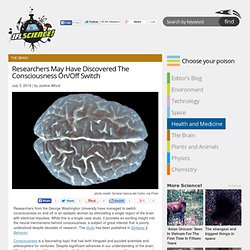
While this is a single case study, it provides an exciting insight into the neural mechanisms behind consciousness, a subject of great interest that is poorly understood despite decades of research. The study has been published in Epilepsy & Behavior. Consciousness is a fascinating topic that has both intrigued and puzzled scientists and philosophers for centuries. The Philosophy of Neuroscience. First published Mon Jun 7, 1999; substantive revision Tue May 25, 2010 Over the past three decades, philosophy of science has grown increasingly “local.”

Concerns have switched from general features of scientific practice to concepts, issues, and puzzles specific to particular disciplines. Philosophy of neuroscience is a natural result. This emerging area was also spurred by remarkable recent growth in the neurosciences. Cognitive and computational neuroscience continues to encroach upon issues traditionally addressed within the humanities, including the nature of consciousness, action, knowledge, and normativity.
Synesthesia — secret passageways in the mansion of memory? – Neurologism. This post is a slightly modified version of my answer to a Quora question: Is there a link between synesthetia and involuntary memory?
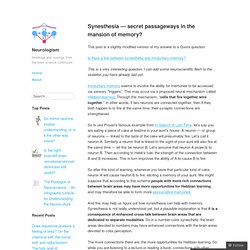
This is a very interesting question. I can add some neuroscientific flesh to the skeleton you have already laid out. Involuntary memory seems to involve the ability for memories to be accessed via sensory “triggers”. This may occur via a proposed neural mechanism called Hebbian learning. So to use Proust’s famous example from In Search of Lost Time, let’s say you are eating a piece of cake at teatime in your aunt’s house. So after this kind of learning, whenever you taste that particular kind of cake, neuron A will cause neuron B to fire, eliciting a memory of your aunt. And this may help us figure out how synesthesia can help with memory.
THE BRAIN FROM TOP TO BOTTOM. Brain Structures and Their Functions. Mapping the human brain connectivity. Real-time brain feedback can help people overcome anxiety. This image from the study shows changes in degree of connectivity in the feedback group.
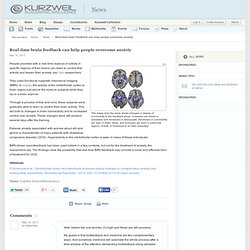
Increases are shown in red/yellow and decreases in blue/purple. Decreases in connectivity are seen in limbic areas, and increases are seen in prefrontal regions. (Credit: D Scheinost et al. /Yale University) People provided with a real-time readout of activity in specific regions of their brains can learn to control that activity and lessen their anxiety, say Yale researchers. BrainVISA/Anatomist Home Page. World's most detailed scans will reveal how brain works. 5 March 2013Last updated at 13:27 ET By Pallab Ghosh Science correspondent, BBC News Continue reading the main story.

Reorganization of neuronal circuits of the central olfactory system during postprandial sleep. Synaptic reorganization in developing and adult nervous systems. JavaScript is disabled on your browser.
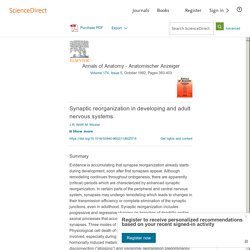
Please enable JavaScript to use all the features on this page. Summary Evidence is accumulating that synapse reorganization already starts during development, soon after first synapses appear. Although remodeling continues throughout ontogenesis, there are apparently (critical) periods which are characterized by enhanced synaptic reorganization.